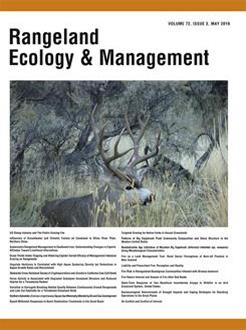Current methods for determining plant age of shrub species require destructive sampling and annual growth ring analysis on the primary stem. Although individual plant ages can frequently be determined in this manner, the method is time consuming and of limited value for plants that have lost stem wood from stem splitting and rot. Nondestructive methods for estimating big sagebrush (Artemisia tridentata Nutt.) plant age would be useful in assessing stand age structure and population dynamics at variable spatial scales. The purpose of this study was to test a suite of traits for potential use in estimating mountain big sagebrush (Artemisia tridentata ssp. vaseyana [Rydb.] Beetle) age. We evaluated traits including plant height, crown area, subcanopy litter depth, percent crown mortality, bark furrow depth, bark fiber length, circumference and diameter of plant basal stem, and circumference of secondary and tertiary branches. We measured and harvested basal cross-sections from 163 plants of varying sizes from five locations in central and south-central Utah. Plant age was determined from annual growth rings. Linear regression analyses revealed that stem diameter (r2 = 0.507 P < 0.0001) was the most highly correlated variable with plant age across all sites, followed by stem circumference (r2 = 0.474 P < 0.0001), secondary branch circumference (r2 = 0.360, P < 0.0001), tertiary branch circumference (r2 = 0.405, P < 0.0001), and bark fiber length (r2 = 0.373, P < 0.0001). Results support previous findings that stem girth has value for estimating mountain big sagebrush plant age and that this trait is a better indicator of age than any other tested traits. Although the relationship between stem diameter and plant age was significant, substantial stem size variability associated with plants of the same approximate age indicates that the method is most appropriate when precise age estimates are not required. This technique was developed specifically for mountain big sagebrush, but it is expected that it can be adapted for other sagebrush taxa.
BioOne.org will be down briefly for maintenance on 17 December 2024 between 18:00-22:00 Pacific Time US. We apologize for any inconvenience.
How to translate text using browser tools
30 April 2019
Nondestructive Age Estimation of Mountain Big Sagebrush (Artemisia tridentata ssp. vaseyana) Using Morphological Characteristics
Melissa L. Landeen,
Stanley G. Kitchen,
Loreen Allphin,
Steven L. Petersen
ACCESS THE FULL ARTICLE

Rangeland Ecology and Management
Vol. 72 • No. 3
May 2019
Vol. 72 • No. 3
May 2019
dendrochronology
plant growth rate
stem diameter
woody plant age estimation




